Computational Study of Graphene–Polypyrrole Composite Electrical Conductivity
Abstract
1. Introduction
2. Electrical Conductivity of Graphene-PPy Composite
3. Results and Discussion
4. Conclusions
Author Contributions
Funding
Acknowledgments
Conflicts of Interest
References
- Díez-Pascual, A.M.; Ashrafi, B.; Naffakh, M.; González-Domínguez, J.M.; Johnston, A.; Simard, B.; Martinez, M.T.; Gómez-Fatou, M.A. Influence of carbon nanotubes on the thermal, electrical and mechanical properties of poly (ether ether ketone)/glass fiber laminates. Carbon 2011, 49, 2817–2833. [Google Scholar] [CrossRef]
- Ivanov, E.; Kotsilkova, R.; Xia, H.; Chen, Y.; Donato, R.K.; Donato, K.; Godoy, A.P.; Di Maio, R.; Silvestre, C.; Cimmino, S. PLA/Graphene/MWCNT composites with improved electrical and thermal properties suitable for FDM 3D printing applications. Appl. Sci. 2019, 9, 1209. [Google Scholar] [CrossRef]
- Zhang, W.; Dehghani-Sanij, A.A.; Blackburn, R.S. Carbon based conductive polymer composites. J. Mater. Sci. 2007, 42, 3408–3418. [Google Scholar] [CrossRef]
- Castellino, M.; Rovere, M.; Shahzad, M.I.; Tagliaferro, A. Conductivity in carbon nanotube polymer composites: A comparison between model and experiment. Compos. Part A Appl. Sci. Manuf. 2016, 87, 237–242. [Google Scholar] [CrossRef]
- Cochrane, C.; Koncar, V.; Lewandowski, M.; Dufour, C. Design and development of a flexible strain sensor for textile structures based on a conductive polymer composite. Sensors 2007, 7, 473–492. [Google Scholar]
- Sahoo, S.; Dhibar, S.; Hatui, G.; Bhattacharya, P.; Das, C.K. Graphene/polypyrrole nanofiber nanocomposite as electrode material for electrochemical supercapacitor. Polymer 2013, 54, 1033–1042. [Google Scholar] [CrossRef]
- Bae, J.-H.; Chang, S.-H. Characterization of an electroactive polymer (PVDF-TrFE) film-type sensor for health monitoring of composite structures. Compos. Struct. 2015, 131, 1090–1098. [Google Scholar] [CrossRef]
- Mohan, V.B.; Lau, K.-t.; Hui, D.; Bhattacharyya, D. Graphene-based materials and their composites: A review on production, applications and product limitations. Compos. Part B Eng. 2018, 142, 200–220. [Google Scholar] [CrossRef]
- Chakraborty, M.; Hashmi, M.S.J. Wonder material graphene: Properties, synthesis and practical applications. Adv. Mater. Process. Technol. 2018, 4, 573–602. [Google Scholar] [CrossRef]
- Ioniţă, M.; Vlăsceanu, G.M.; Watzlawek, A.A.; Voicu, S.I.; Burns, J.S.; Iovu, H. Graphene and functionalized graphene: Extraordinary prospects for nanobiocomposite materials. Compos. Part B Eng. 2017, 121, 34–57. [Google Scholar] [CrossRef]
- Rosas-Laverde, N.M.; Pruna, A.; Busquets-Mataix, D. Improving Electrochemical Properties of Polypyrrole Coatings by Graphene Oxide and Carbon Nanotubes. Nanomaterials 2020, 10, 507. [Google Scholar] [CrossRef]
- Gupta, S.; Price, C. Investigating graphene/conducting polymer hybrid layered composites as pseudocapacitors: Interplay of heterogeneous electron transfer, electric double layers and mechanical stability. Compos. Part B Eng. 2016, 105, 46–59. [Google Scholar] [CrossRef]
- Ahmed, J.; Tabish, T.A.; Zhang, S.; Edirisinghe, M. Porous Graphene Composite Polymer Fibres. Polymers 2021, 13, 76. [Google Scholar] [CrossRef] [PubMed]
- Han, S.; Wu, D.; Li, S.; Zhang, F.; Feng, X. Porous graphene materials for advanced electrochemical energy storage and conversion devices. Adv. Mater. 2014, 26, 849–864. [Google Scholar] [CrossRef] [PubMed]
- Zhang, X.; Samorì, P. Graphene/polymer nanocomposites for supercapacitors. ChemNanoMat 2017, 3, 362–372. [Google Scholar] [CrossRef]
- Ramanavicius, S.; Ramanavicius, A. Conducting Polymers in the Design of Biosensors and Biofuel Cells. Polymers 2021, 13, 49. [Google Scholar] [CrossRef]
- Zhang, Y.; Bakenov, Z.; Tan, T.; Huang, J. Three-dimensional hierarchical porous structure of PPy/porous-graphene to encapsulate polysulfides for lithium/sulfur batteries. Nanomaterials 2018, 8, 606. [Google Scholar] [CrossRef]
- Zhang, Y.-F.; Zhao, Y.-H.; Bai, S.-L.; Yuan, X. Numerical simulation of thermal conductivity of graphene filled polymer composites. Compos. Part B Eng. 2016, 106, 324–331. [Google Scholar] [CrossRef]
- Mutiso, R.; Winey, K. Electrical conductivity of polymer nanocomposites. In Proceedings of the APS March Meeting 2012, Boston, MA, USA, 27 February–2 March 2012; Volume 2012, p. W44-007. [Google Scholar]
- Folorunso, O.; Hamam, Y.; Sadiku, R.; Ray, S.S.; Joseph, A.G. Parametric analysis of electrical conductivity of polymer-composites. Polymers 2019, 11, 1250. [Google Scholar] [CrossRef]
- Hu, N.; Masuda, Z.; Yan, C.; Yamamoto, G.; Fukunaga, H.; Hashida, T. The electrical properties of polymer nanocomposites with carbon nanotube fillers. Nanotechnology 2008, 19, 215701. [Google Scholar] [CrossRef]
- Nan, C.; Shen, Y.; Ma, J. Physical properties of composites near percolation. Annu. Rev. Mater. Res. 2010, 40, 131–151. [Google Scholar] [CrossRef]
- Fang, C.; Zhang, J.; Chen, X.; Weng, G.J. A Monte Carlo model with equipotential approximation and tunneling resistance for the electrical conductivity of carbon nanotube polymer composites. Carbon 2019, 146, 125–138. [Google Scholar] [CrossRef]
- Yu, Y.; Song, G.; Sun, L. Determinant role of tunneling resistance in electrical conductivity of polymer composites reinforced by well dispersed carbon nanotubes. J. Appl. Phys. 2010, 108, 084319. [Google Scholar] [CrossRef]
- Gong, S.; Zhu, Z.; Meguid, S. Anisotropic electrical conductivity of polymer composites with aligned carbon nanotubes. Polymer 2015, 56, 498–506. [Google Scholar] [CrossRef]
- Li, C.; Thostenson, E.T.; Chou, T.-W. Dominant role of tunneling resistance in the electrical conductivity of carbon nanotube–based composites. Appl. Phys. Lett. 2007, 91, 223114. [Google Scholar] [CrossRef]
- Ebbesen, T.; Lezec, H.; Hiura, H.; Bennett, J.; Ghaemi, H.; Thio, T. Electrical conductivity of individual carbon nanotubes. Nature 1996, 382, 54–56. [Google Scholar] [CrossRef]
- Buldum, A.; Lu, J.P. Contact resistance between carbon nanotubes. Phys. Rev. B 2001, 63, 161403. [Google Scholar] [CrossRef]
- Venugopal, A.; Colombo, L.; Vogel, E. Contact resistance in few and multilayer graphene devices. Appl. Phys. Lett. 2010, 96, 013512. [Google Scholar] [CrossRef]
- Ang, Y.S.; Cao, L.; Ang, L.K. Physics of electron emission and injection in two-dimensional materials: Theory and simulation. InfoMat 2021. [Google Scholar] [CrossRef]
- Ang, Y.S.; Yang, H.Y.; Ang, L. Universal scaling laws in Schottky heterostructures based on two-dimensional materials. Phys. Rev. Lett. 2018, 121, 056802. [Google Scholar] [CrossRef]
- Ang, Y.S.; Ang, L. Theory of thermionic carrier injection in graphene/organic Schottky interface. Front. Mater. 2019, 6, 204. [Google Scholar] [CrossRef]
- Banerjee, S.; Cao, L.; Ang, Y.S.; Ang, L.; Zhang, P. Reducing contact resistance in two-dimensional-material-based electrical contacts by roughness engineering. Phys. Rev. Appl. 2020, 13, 064021. [Google Scholar] [CrossRef]
- Simmons, J.G. Generalized thermal J-V characteristic for the electric tunnel effect. J. Appl. Phys. 1964, 35, 2655–2658. [Google Scholar] [CrossRef]
- McCullough, R.L. Generalized combining rules for predicting transport properties of composite materials. Compos. Sci. Technol. 1985, 22, 3–21. [Google Scholar] [CrossRef]
- Stankovich, S.; Dikin, D.A.; Dommett, G.H.; Kohlhaas, K.M.; Zimney, E.J.; Stach, E.A.; Piner, R.D.; Nguyen, S.T.; Ruoff, R.S. Graphene-based composite materials. Nature 2006, 442, 282–286. [Google Scholar] [CrossRef] [PubMed]
- Kim, S.Y.; Noh, Y.J.; Yu, J. Prediction and experimental validation of electrical percolation by applying a modified micromechanics model considering multiple heterogeneous inclusions. Compos. Sci. Technol. 2015, 106, 156–162. [Google Scholar] [CrossRef]
- Zabihi, Z.; Araghi, H. Monte Carlo simulations of effective electrical conductivity of graphene/poly (methyl methacrylate) nanocomposite: Landauer-Buttiker approach. Synth. Met. 2016, 217, 87–93. [Google Scholar] [CrossRef]
- Fang, C.; Zhang, J.; Chen, X.; Weng, G.J. Calculating the Electrical Conductivity of Graphene Nanoplatelet Polymer Composites by a Monte Carlo Method. Nanomaterials 2020, 10, 1129. [Google Scholar] [CrossRef]
- Gong, S.; Zhu, Z.; Meguid, S. Carbon nanotube agglomeration effect on piezoresistivity of polymer nanocomposites. Polymer 2014, 55, 5488–5499. [Google Scholar] [CrossRef]
- Weihull, W. A statistical distribution function of wide applicability. J. Appl. Mech. 1951, 18, 290–293. [Google Scholar]
- Naghdi, S.; Sanchez-Arriaga, G.; Rhee, K.Y. Tuning the work function of graphene toward application as anode and cathode. J. Alloy. Compd. 2019, 805, 1117–1134. [Google Scholar] [CrossRef]
- Erdönmez, S.; Karabul, Y.; Bulgurcuoğlu, A.E.; Kilic, M.; Özdemir, Z.G.; Icelli, O. Sodium meta silicate doped PPy and PT composites with giant dielectric constant. IEEE Trans. Dielectr. Electr. Insul. 2017, 24, 3031–3037. [Google Scholar] [CrossRef]
- Moldoveanu, S.; David, V. Solvents, Buffers, and Additives Used in the Mobile Phase. In MOLDOVEANU, SC, Selection of the HPLC Method in Chemical Analysis; Elsevier: Amsterdam, The Netherlands, 2017; pp. 393–450. [Google Scholar]
- Tarani, E.; Wurm, A.; Schick, C.; Bikiaris, D.; Chrissafis, K.; Vourlias, G. Effect of graphene nanoplatelets diameter on non-isothermal crystallization kinetics and melting behavior of high density polyethylene nanocomposites. Thermochim. Acta 2016, 643, 94–103. [Google Scholar] [CrossRef]
- Gong, S.; Zhu, Z.; Haddad, E. Modeling electrical conductivity of nanocomposites by considering carbon nanotube deformation at nanotube junctions. J. Appl. Phys. 2013, 114, 074303. [Google Scholar] [CrossRef]
- Zhang, B.; Xu, Y.; Zheng, Y.; Dai, L.; Zhang, M.; Yang, J.; Chen, Y.; Chen, X.; Zhou, J. A facile synthesis of polypyrrole/carbon nanotube composites with ultrathin, uniform and thickness-tunable polypyrrole shells. Nanoscale Res. Lett. 2011, 6, 431. [Google Scholar] [CrossRef]
- Chang, H.-H.; Chang, C.-K.; Tsai, Y.-C.; Liao, C.-S. Electrochemically synthesized graphene/polypyrrole composites and their use in supercapacitor. Carbon 2012, 50, 2331–2336. [Google Scholar] [CrossRef]
- Alian, A.; Meguid, S. Multiscale modeling of the coupled electromechanical behavior of multifunctional nanocomposites. Compos. Struct. 2019, 208, 826–835. [Google Scholar] [CrossRef]
- Manta, A.; Gresil, M.; Soutis, C. Predictive model of graphene based polymer nanocomposites: Electrical performance. Appl. Compos. Mater. 2017, 24, 281–300. [Google Scholar] [CrossRef]
- Folorunso, O.; Hamam, Y.; Sadiku, R.; Ray, S.S.; Adekoya, G.J. Electrical Resistance control model for polypyrrole-graphene nanocomposite: Energy storage applications. Mater. Today Commun. 2020, 101699. [Google Scholar] [CrossRef]
- Haghgoo, M.; Ansari, R.; Hassanzadeh-Aghdam, M. Prediction of electrical conductivity of carbon fiber-carbon nanotube-reinforced polymer hybrid composites. Compos. Part B Eng. 2019, 167, 728–735. [Google Scholar] [CrossRef]
- Payandehpeyman, J.; Mazaheri, M.; Khamehchi, M. Prediction of electrical conductivity of polymer-graphene nanocomposites by developing an analytical model considering interphase, tunneling and geometry effects. Compos. Commun. 2020, 21, 100364. [Google Scholar] [CrossRef]
- Forouzandeh, P.; Kumaravel, V.; Pillai, S.C. Electrode Materials for Supercapacitors: A Review of Recent Advances. Catalysts 2020, 10, 969. [Google Scholar] [CrossRef]
- Raravikar, N.R.; Schadler, L.S.; Vijayaraghavan, A.; Zhao, Y.; Wei, B.; Ajayan, P.M. Synthesis and characterization of thickness-aligned carbon nanotube− polymer composite films. Chem. Mater. 2005, 17, 974–983. [Google Scholar]
- Han, X.; Chen, S.; Lv, X.; Luo, H.; Zhang, D.; Bowen, C.R. Using a novel rigid-fluoride polymer to control the interfacial thickness of graphene and tailor the dielectric behavior of poly (vinylidene fluoride–trifluoroethylene–chlorotrifluoroethylene) nanocomposites. Phys. Chem. Chem. Phys. 2018, 20, 2826–2837. [Google Scholar] [CrossRef]
- Zhang, P. Scaling for quantum tunneling current in nano-and subnano-scale plasmonic junctions. Sci. Rep. 2015, 5, 1–11. [Google Scholar] [CrossRef] [PubMed]
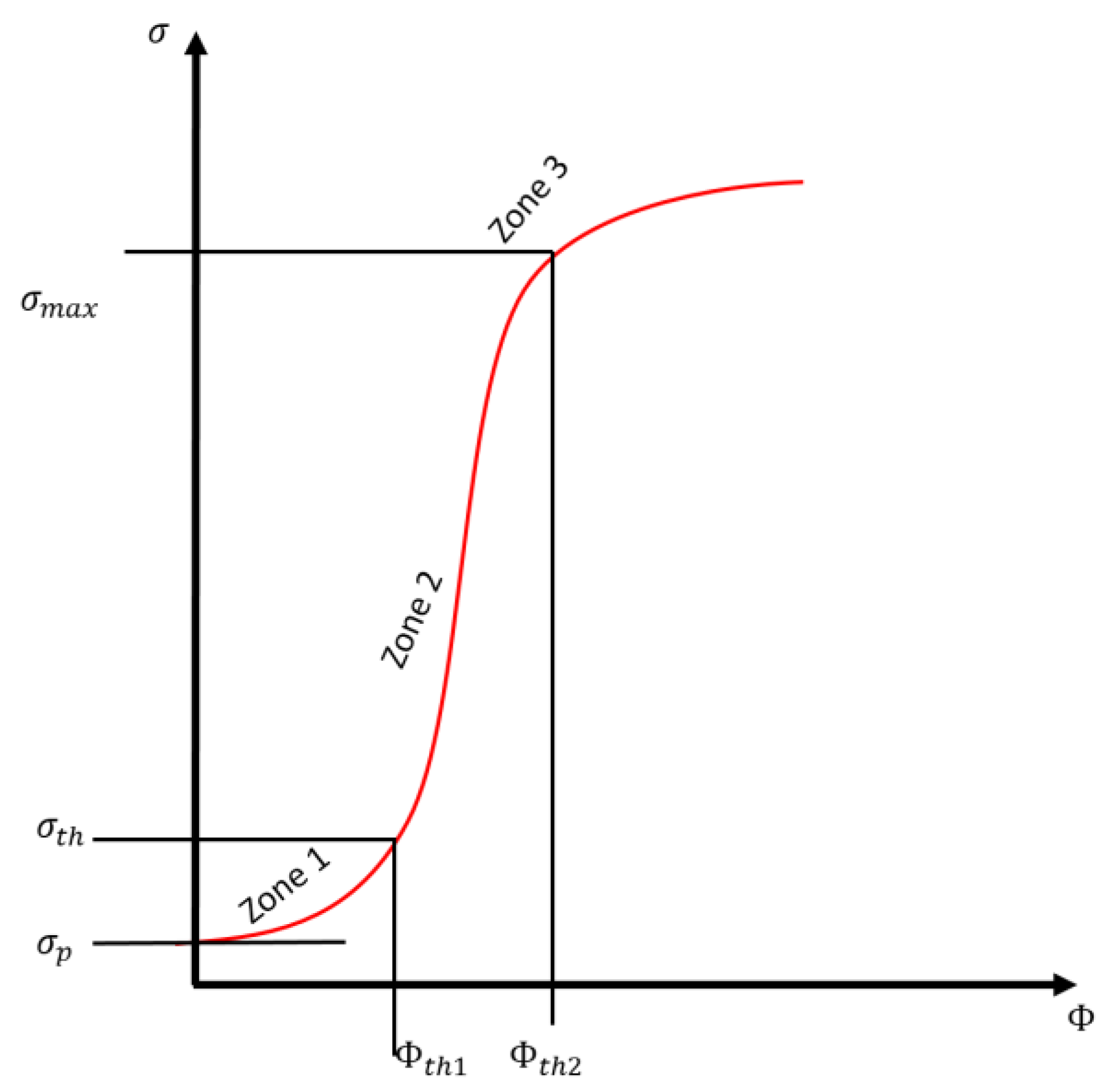
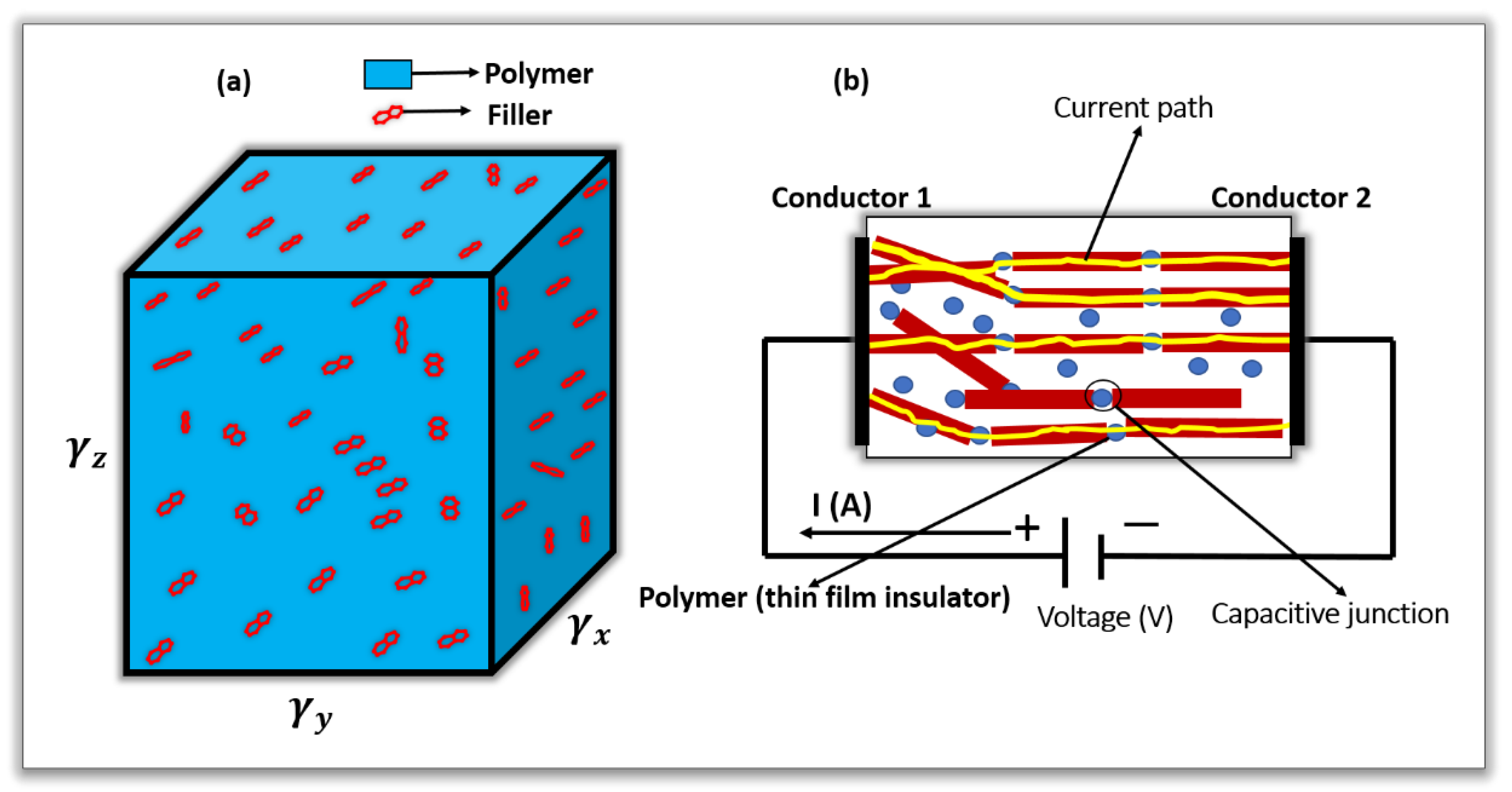

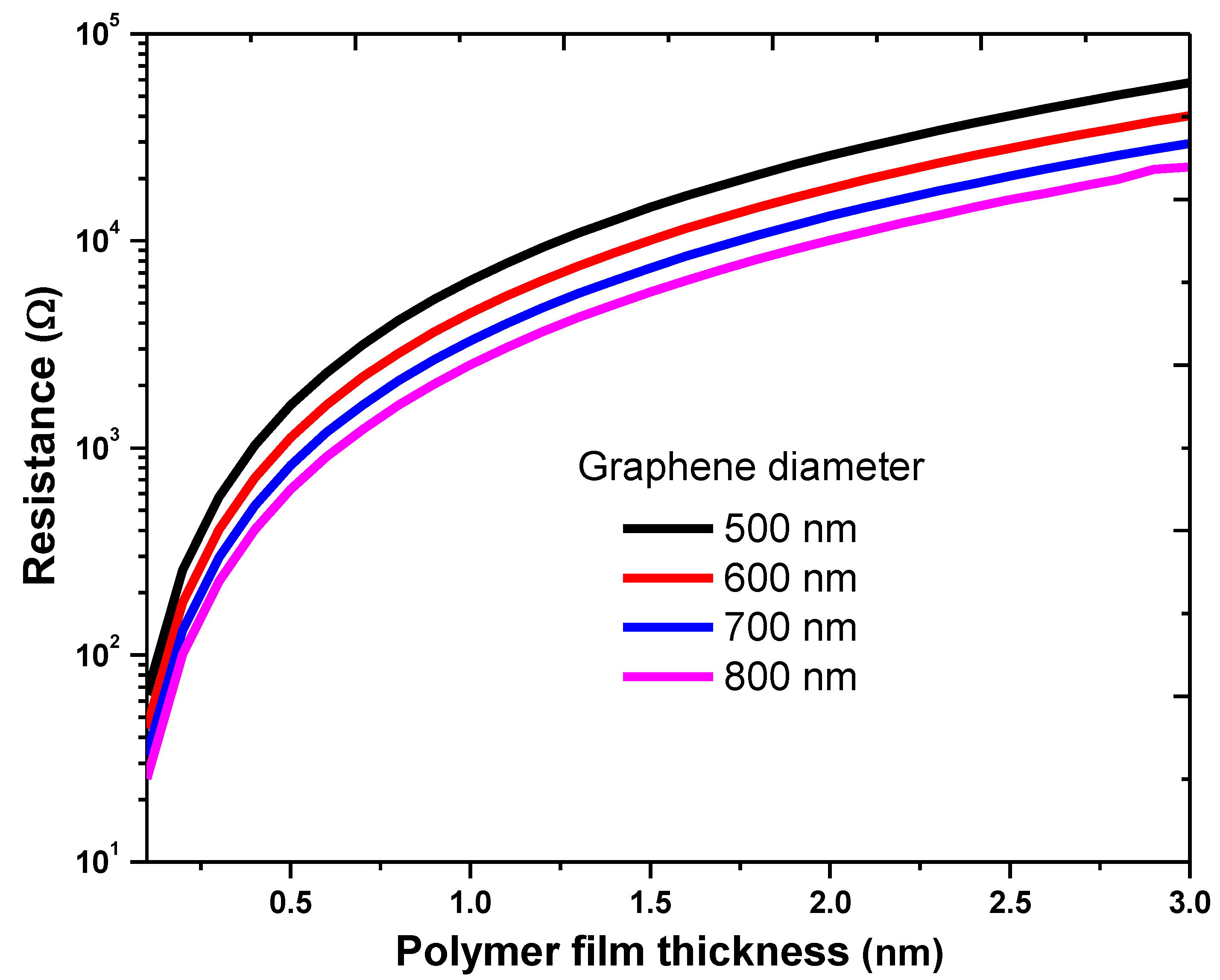
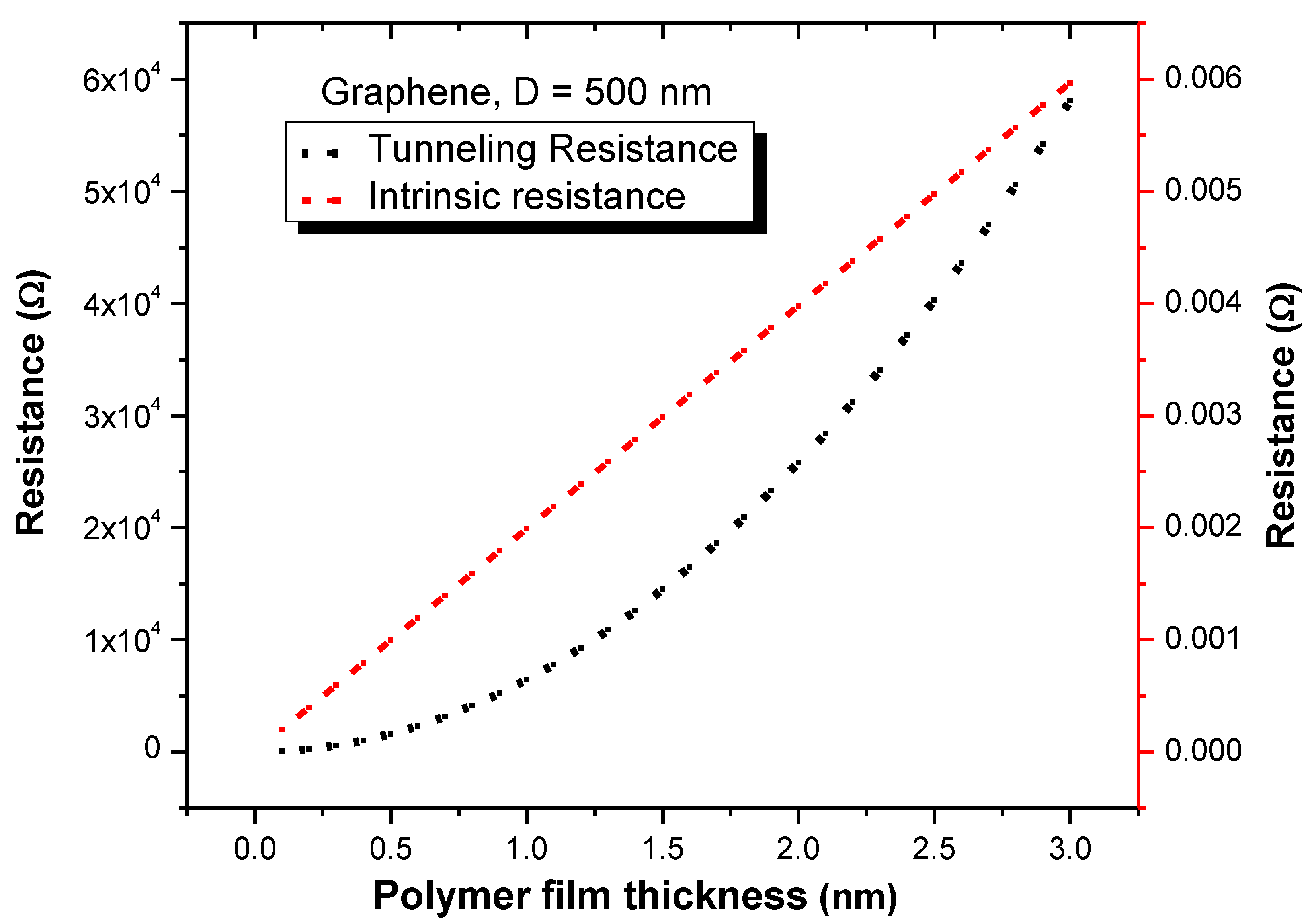
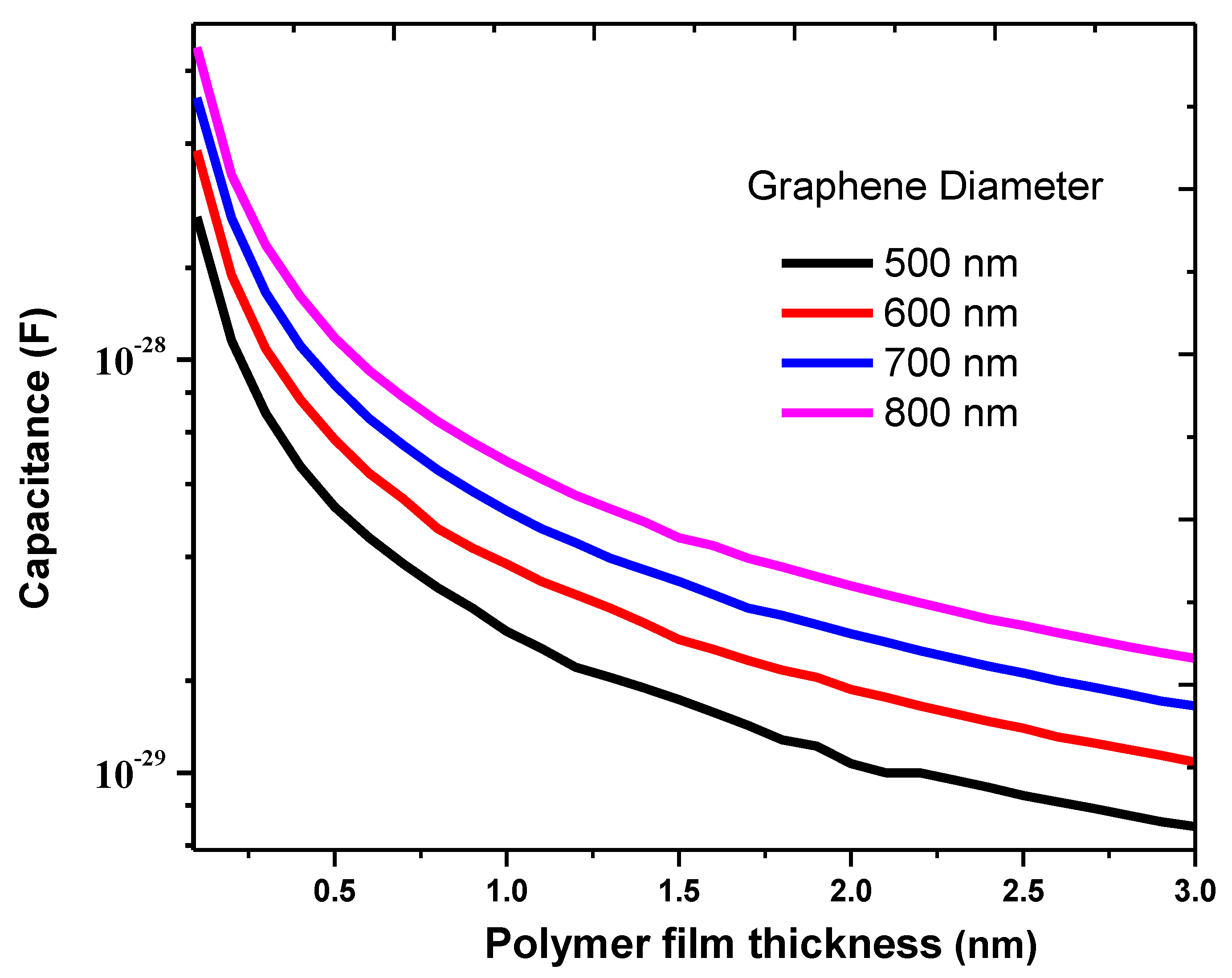



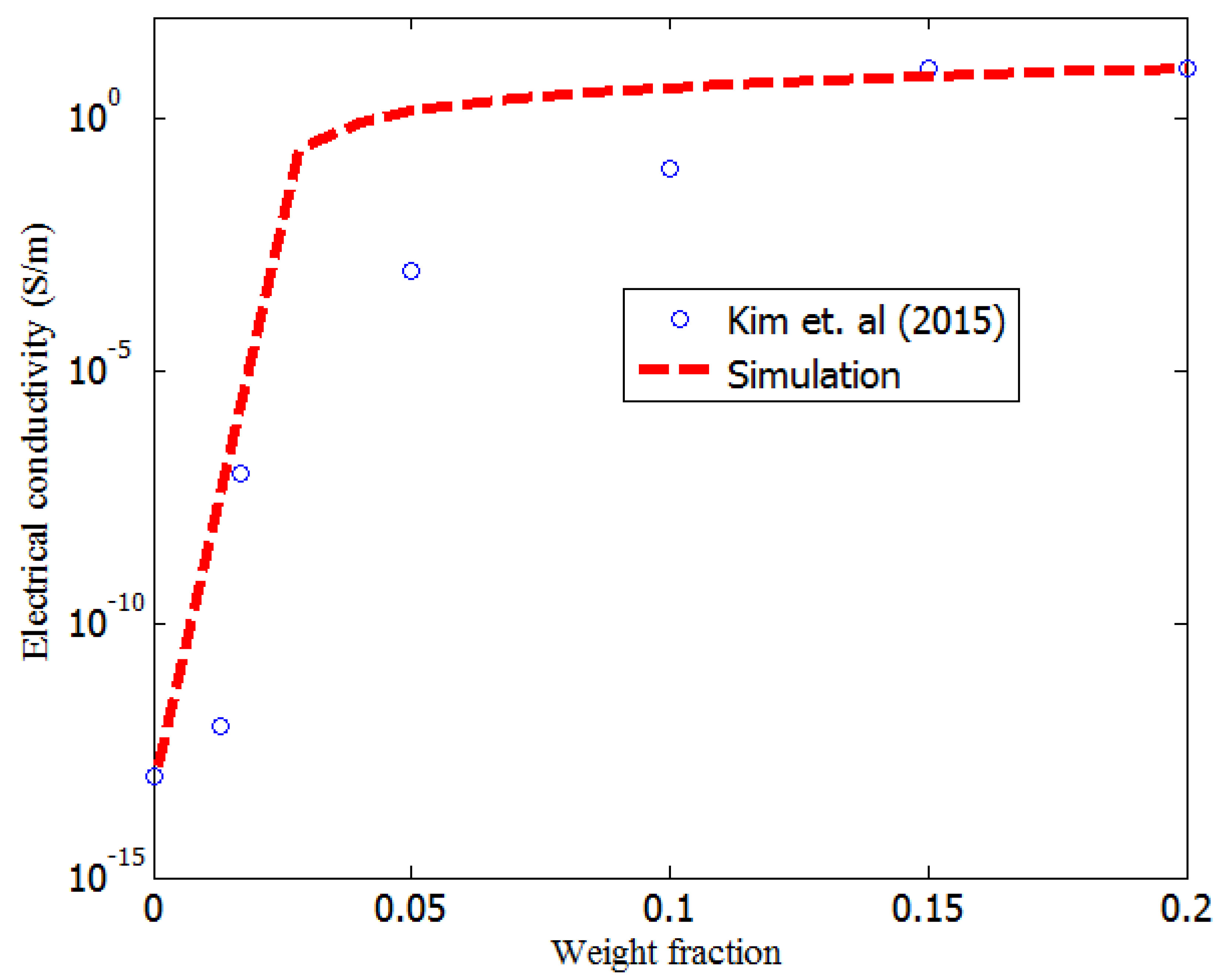
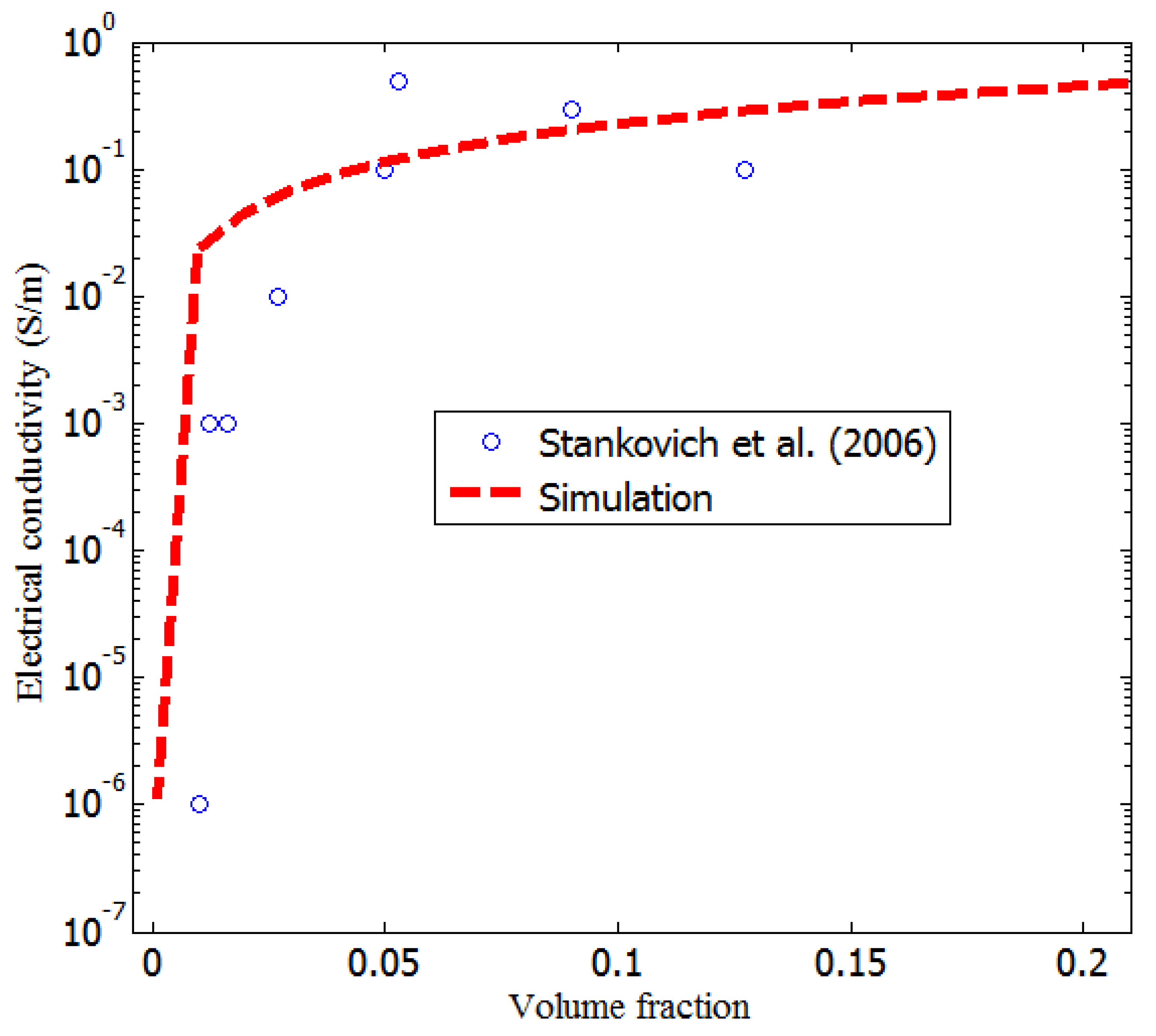
| Parameters | Meaning | Unit |
|---|---|---|
| Current density | ||
| Limits of insulating barriers at Fermi level | ||
| Thickness of polymer insulating film | ||
| Decay parameter | ||
| Mean barrier height | eV | |
| Height of rectangular barrier | eV | |
| Bias voltage | V | |
| Insulator dielectric constant | ||
| Planck constant | Js | |
| Mass of electron | kg | |
| Electronic charge | C | |
| Permittivity of free space | F/m | |
| C | Junction capacitance | F |
| Filler cross-sectional area | ||
| Filler volume fraction | ||
| Polymer volume fraction | ||
| Polymer conductivity | S/m | |
| Filler conductivity | S/m | |
| Filler length factor | nm | |
| Filler length | ||
| Dimension of cuboid RVE | ||
| and | Polar and azimuthal angles | |
| rnd | Random values | |
| Filler diameter | nm | |
| Weibull PDF |
Publisher’s Note: MDPI stays neutral with regard to jurisdictional claims in published maps and institutional affiliations. |
© 2021 by the authors. Licensee MDPI, Basel, Switzerland. This article is an open access article distributed under the terms and conditions of the Creative Commons Attribution (CC BY) license (http://creativecommons.org/licenses/by/4.0/).
Share and Cite
Folorunso, O.; Hamam, Y.; Sadiku, R.; Ray, S.S. Computational Study of Graphene–Polypyrrole Composite Electrical Conductivity. Nanomaterials 2021, 11, 827. https://doi.org/10.3390/nano11040827
Folorunso O, Hamam Y, Sadiku R, Ray SS. Computational Study of Graphene–Polypyrrole Composite Electrical Conductivity. Nanomaterials. 2021; 11(4):827. https://doi.org/10.3390/nano11040827
Chicago/Turabian StyleFolorunso, Oladipo, Yskandar Hamam, Rotimi Sadiku, and Suprakas Sinha Ray. 2021. "Computational Study of Graphene–Polypyrrole Composite Electrical Conductivity" Nanomaterials 11, no. 4: 827. https://doi.org/10.3390/nano11040827
APA StyleFolorunso, O., Hamam, Y., Sadiku, R., & Ray, S. S. (2021). Computational Study of Graphene–Polypyrrole Composite Electrical Conductivity. Nanomaterials, 11(4), 827. https://doi.org/10.3390/nano11040827








